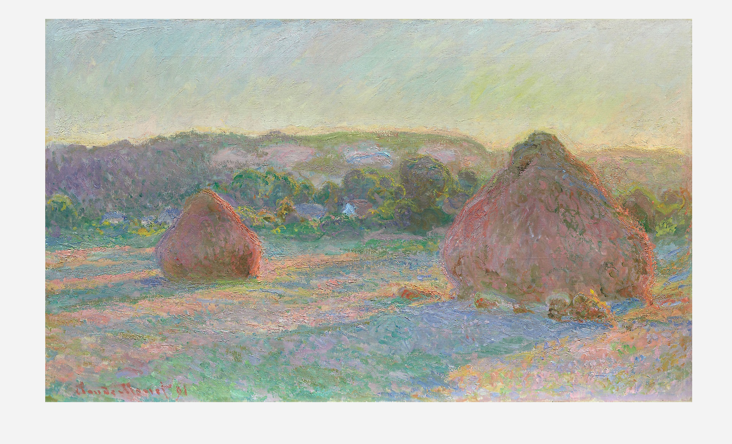
Stacks of Wheat (End of Summer) (1890/91) by Claude Monet is an oil painting on canvas that was a part of a series of similar landscapes, the subject of which “stood just outside the painter’s farmhouse” (“Stacks of Wheat (End of Summer)”). The impressionist series depicting the same stack of hay is notable for the ability of Monet to repeat the same them but to capture different atmospheres, times of day, and times of the year. The End of Summer version shows a perfect balance between cold and warm tones, a clear sky, and sunlit nature that is peaceful and calming to the eye. The seasonal manifestations of nature and the color harmonies inherent to the image show that the subject matter was chosen carefully and was a product of Monet’s careful analysis and thought.
Two stacks of hay represent the central focus of the composition. They are of different sizes, and one is located closer to the viewer as well as closer to the frame of the painting. The haystacks are loosely triangular in shape but have some curves at the sides. The grass underneath the stacks is multi-colored and multi-dimensional, which shows a unique play with light and color balance. There are green, blue, yellow, brown, and even pink hues in the grass, and the transition between the colors transfers the change of seasons. While green is one of the dominant colors of the paintings and represents the summer, the yellows and browns that Monet used strategically hint at the season’s ending and that warm tones would soon be overwhelming the landscape.
The composition of the painting is balanced by dark green trees that are located between the two stacks of hay. From the first look, it may seem that the trees in the background have some significance or meaning within the composition. However, it appears that Monet was showing the play of colors and textures in the nature of a late summer day. The skies are not completely blue, which means that the time of day is close to the sunset as the majority of light comes from behind the trees and shines at an angle. The setting sun gives distinct warmth to the entire painting and gives it a particular mood – the summer is still here, but mother nature is hinting that fall will come soon and change the scenery. In the same way in which the painting shows a balance in composition, there is a balance in how nature transforms and affects the view observed by human beings. The critical effect that Monet wanted to reach in the design is showing that nothing is constant, strictly defined, and one-toned in nature: seasons do not end abruptly but rather ‘infiltrate’ slowly and gradually change the scenery. Stacks of Wheat is an intelligent and carefully planned painting, the intention of which was to show the continuity of life and the need for people to see the beauty in each moment and realizing that the end of summer means the start of something new.
Work Cited
Stacks of Wheat (End of Summer).”Art Institute Chicago, Web.